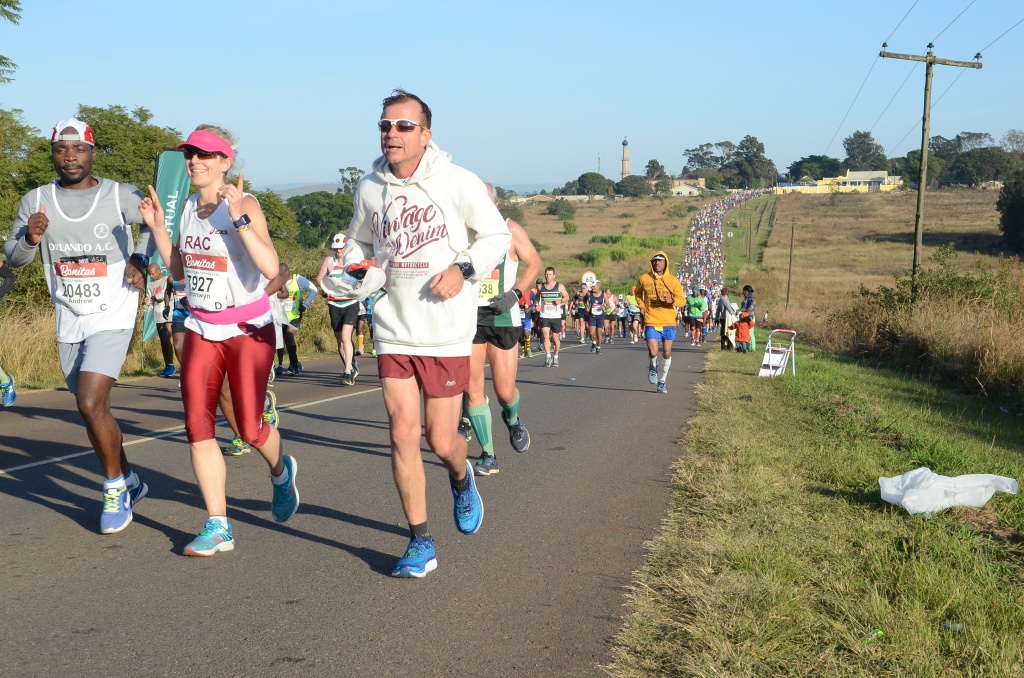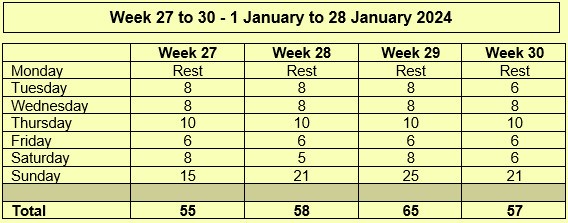Week 27 to Week 30. 1 January to 28 January – 2024.
Based on training schedules of the late Don Oliver, Comrades Coach. Adapted and edited by Tom Cottrell.
Only the committed will survive

You can’t be half-hearted about Comrades. You can’t be half-hearted on the Big Day and any other day between January and June. If you really want a medal you have to fix all your thoughts on it now. Today! Amongst the approximately 16% of Comrades failures each year probably, half of them were just feeling how they would feel at half way. They weren’t sure. They did not want to commit themselves either in their training or the race itself. Comrades finishers are made of better stuff. Maybe they didn’t all look like Olympic athletes but inside, where you can’t see, they are tough. They are dedicated people who have got used to achieving just a little bit more each time. Wonderful people. Most of my friends are Comrades medallists – different people.
If you want to be one of those very special people who has got a Comrades medal, take some advice and commit yourself today as you read this article. Then quietly get on with the job of training conscientiously, every day, according to the plan. If you are a fence sitter who always waits to see, before they commit themselves, don’t waste R1200 on the Comrades entry fee. Stay at home.
Sign the little Commitment Card given in a previous article – (Click here) Keep it to yourself; it’s personal but keep taking it out when the going gets tough and remind yourself what you have secretly promised yourself, your family and friends.
We at “RunnersGuide” will take your hand and guide you along every step of the way. You’re in good hands and we’ve seen it work with thousands like yourself over many many years.
Where are we now?
January is very very different from the previous four months. We are now stepping out seriously on to our official Comrades Training Programme. From August to December we laid beautiful foundation bricks so we can build on these 5½ months of progressive training. We do it each month with “biteable bits” and “chewable chunks”. One Step at a Time. Our programme leads you to a new target each month only after you have successfully completed a significant stepping stone the month before.
We go from 21 kms to 32 kms to 42,2 kms a step at a time. After we’ve qualified in March (1st week) we enter the wonderful world of “beyond the marathon”. What a wonderful country that is. The real big boys are out there – the ultra marathoners. They shuffle, walk, laugh, stop, and have funny little superstitions. Habits and dress habits (Don Oliver always had one folded hankie for a standard and two for an ultra – he did that for 22 years). Another friend Tombstone Tabakin (18 medals) had a red bandanna with white polka dots. He wore it from 1967 to 1993 – same one. I always carried a small stone from home in my pocket, returning to its rightful place on my return after the race. It’s a wonderful feeling passing through the standard marathon mark and into the big world leading to 52, 56 and finally 86 kms. We’ll take you there.
Thank you for running roughly 765 kms between September and the end of December. Now you can close that running bank account. The old Comrades runners talk about how much training they do for Comrades and they refer to January 1st to June every year. The 765 kms is not lost, on the contrary it will stand you in good stead from January to June. Without it you would not be able to tackle this programme. Everyone wants to know how many kilometres we have to do for Comrades. Less than 800 kms is really not enough to take on the Big C unless you are very young, very strong and a natural sportsman you may just make it. If you do more than 1800 kms you will be a prime candidate for not finishing Comrades if you are a novice. You will be tired, partially injured; just getting or getting over flu and these are the 16% who don’t finish the Comrades Marathon. That’s your window.
Life will be about windows from now on. Little gaps that you must pass through at every stage to be sure you qualify and finish. For example, our window to qualify for Comrades is between 4 hours 30 mins and 4hours 50 mins. Faster than four hours is unnecessary and too close to 4 hours 55 mins is pushing your luck and must ask yourself if you are a suitable starter in Durban. Our programme takes us into the Ultras and finally to the Long Club Run of 62 kms. Do that in less than 8 hours and you can book your medal. Faster than 7 hours and you are racing 4 weeks before Comrades, which breaks more than a couple of rules.
Your stepping stone for this month is only to do a 25 km club run in less than 3 hours 10 mins during January. Not too frightening but of course nothing is frightening about training for Comrades if you are in good hands.
How do we know how we are doing?
There are several telltale signs that you are getting better. Your resting pulse rate, measured before you get out of bed in the morning, will drop by up to 10 beats per minute as you get fitter. Your mass might drop a little. Measure your mass nude in the morning before a run once a week, on the same day. Record it in your diary.
The very oldest but the truest measure of fitness is the “talk test”. You should be able to hold a sensible conversation while you are running be it in training or a race.
You will be finishing each and every training run and race with a “little bit in hand”. That means you could have gone for a little bit longer or could have run a little bit faster. You are the judge.
It’s a wonderful feeling getting fitter. Finally you would expect to be running injury free. If not, either your shoes are wrong or you are going a bit too fast. The distance is about right if you really want to do Comrades. You should never really have sore legs at this stage. If you are feeling a little tired or weary in the afternoon at work you might have to allocate another hour to sleeping – to bed earlier. If you are doing alternative exercise, like hard gym, cycling, canoeing you might consider right now that you would have to cut these other activities down for 5 or 6 months. It will be worth it.
Let’s just have a look at “where are we now”
| Month | Monthly km | Longest run |
| Sept | 125 | 15 km |
| Oct | 170 | 15 km |
| Nov | 250 | 21 km |
| Dec | 220 | 21 km |
| Total | 765 |
These are the ingredients of success. Slow build up. Yes we started in September on only 4 days per week training and now in December we are getting in to the real road runners pattern of only one rest day per week. December training is good mileage but not too much.
Your January Training Programme.
We would like you to take a short step to our first stepping stone. In June by using little stepping stones we will take our final step from 62 kms to 87 kms. Oh dear, that last stepping stone of 25 kms is equal to our kilometre step this month. Don’t worry. I would like you to put in a club run very slowly for 25 kms at your own speed. I would like you to get up to 25 kms to be ready for your 32 kms in February.
Period: 1st January to 28th January
Objective: Complete a half marathon in your second week and a club run of 25 kms in less than 3 hours including all stops.
How to measure if you have achieved it: Take part in a formal club run of 25 kms and take 3 hours from starting off to getting back to the start within 3 hours.
How to achieve it:
As we increase the distance we decrease the speed.
- Run a little bit slower all the way than your last 21 kms.
- Walk a little if you feel like it. Not for long, then say, “Let’s get going again”.
- Get used to tiredness. You’re never tireder than tired.
- Finish each run with a “little bit in hand”.
- Chat along the way.
- Drink on club runs.
- Go gently on Tuesday and Wednesday following your longer Sunday run.
- Don’t show off on the Sunday run by going too fast. A little tip: – “Run on Sunday and think of Wednesday”.
- Enjoy the summer – winter is hard!

Thought for the month: “I’VE REALLY STARTED NOW AND I WON’T GIVE UP”
You have now put in place a six day a week running schedule and have done a half marathon race as a training run in sub 2 hours 20 mins. And you have gone a bit further – to 25 kilometres.

You must be logged in to post a comment.